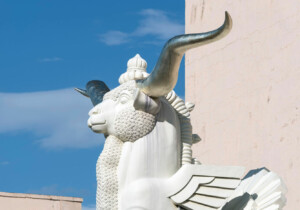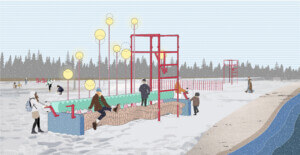The divisiveness of the U.S.-Mexico border wall’s construction in recent years has prompted members of the creative community to develop public protest art in response. Consider, in the last year alone, the bright pink seesaws Ronald Rael installed through the brown steel slats between Ciudad Juárez and New Mexico’s Sunland Park, or the Golden Wall fencing “prototype” New World Design proposed outside of the president’s Mar-a-Lago compound and golf course in Florida.
The newest in the genre is a light installation erected by artist Rafael Lozano-Hemmer that, much like Rael’s seesaws in particular, aims to bridge communication where the U.S. government strove to disrupt it. The installation, Border Tuner, placed spotlights on either side of the border of El Paso, Texas, and Ciudad Juárez, Mexico, for members of either city to operate. Attached to each spotlight was a microphone in which visitors were encouraged to voice their thoughts and, when the lights intersected in the sky over the border wall, a two-way channel of communication was opened, allowing the two to hear each other’s voices over loudspeakers. The intensity of the light beams was determined by the voices of participants, illuminating the divided sky by the cadence of vocal expression. For those who couldn’t visit either site in person, they could have sent send pre-recorded messages online and watched the event take place on a livestream.
Each night of the installation began with performances by local activists, artists, historians, and others whose indigenous voices confirmed the importance of communication in the globalized present against the suppressive agents that divide it. A physical wall may drive a wedge between cultures on the ground, but it can’t control what happens in the sky above it. “The idea that the artwork takes place above that wall to me is symbolically important because it’s almost like you’re trying to ignore it,” said Lozano-Hemmer. “You’re trying to say we still share the atmosphere.”
Though Border Tuner closed to the public on November 24 after opening on November 13, there will certainly be other installations to replace it as artists continue to explore the shared culture of the communities on either side of the border.











